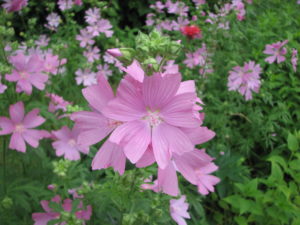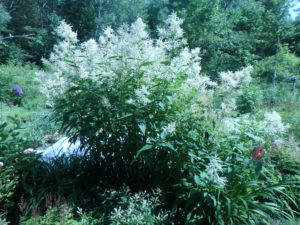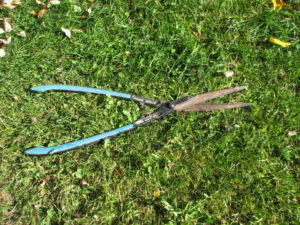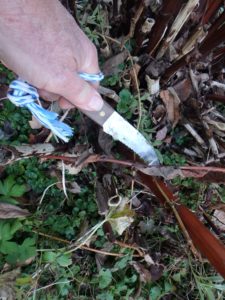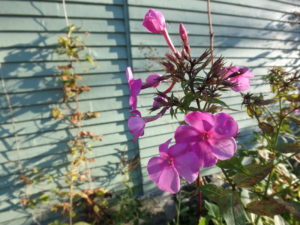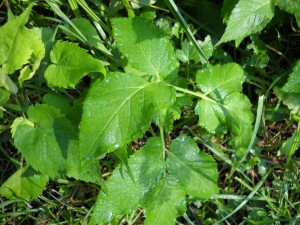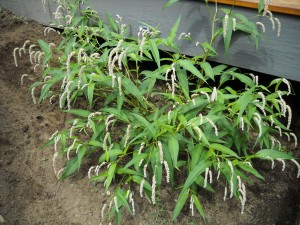Garden Thugs to Love or Hate
Just coming in to bloom for me right now is pink or hollyhock mallow (Malva alcea). Each plant presents lots of bright pink blossoms over several weeks that are about 1½ inches wide. She is generous, offering babies that mysteriously pop up all over my garden. There is a big clump blooming in my vegetable garden right now that I definitely did not plant.
Pink mallow grows to be 3 to 4 feet tall and 18 inches wide when grown in full sun. It is drought tolerant and not fussy about soil. It does tend to flop, however, so it often needs to be staked. It has a fleshy root and hates to be moved except when very young.
Beebalm (Monarda didyma) is one of my favorites, despite the fact that it spreads by root and cannot be contained. The blossoms are large and fragrant, and it is an excellent cut flower.
Beebalm is a tall plant (mine are 3 to 5 feet tall) on square stems. I have it planted up against a rock wall and fronted by a lawn, so it is contained on 2 sides. A lawnmower is a very effective tool against the spread of any flower. The good news is this: it is very easy to pull out volunteers.
Many gardening books list beebalm as a “full-sun” plant. My books do not. I recommend planting it where it gets morning sun only. I have found that full sun dries it out too quickly and reduces its bloom time and beauty. Hot afternoon sun is often too strong for this plant, particularly in sandy soils. For me it grows and blooms in quite shady places, and loves moist soil.
The “common” orange daylily (Hemerocallis fulva) is frequently disparaged by gardeners, but not by me. It really will grow anywhere, in any soil and is not deterred by bugs, slugs or predatory herbivores. Or at least not in my experience. I once dug out a clump from a flower bed at the end of the day and dropped it on the lawn. At the time I was an electrician working long hours all week and gardening only on weekends. By the next weekend it had dug its fingers into the soil (Okay, its roots) and I left it there. Now 20 years later it is still there and beautiful when it blooms.
The fancy varieties of daylilies stay in a nice clump that get bigger each year, but don’t really spread. The orange one does spread by root, and can be difficult to contain. But I have some growing right by the road in shade and truly awful soil, and they will be blooming shortly. I also have a double orange that spreads by root, but is a bit flashier.
A plant you might not know is giant fleeceflower (Persicaria polymorpha). It is quite wonderful – it can get to be 8 to 10 feet tall with white fleecy flowers that persist much of the summer . It thrives in full sun and moist soil, but will grow almost anywhere.
Why might some consider it a thug? It gets bigger and the clump gets wider every year. And if you do not discipline it, it may well steam-roller favorite plants nearby. It has an amazing root system that will challenge most gardeners. So be sure you have a 6- to 8-foot wide space for it to dominate.
You probably know lobelia as a short annual plant (Lobelia erinus) that has intense blue or purple flowers and will bloom even in shade. Or perhaps you grow cardinal flower (L. cardinalis), a tall bright red, late-summer bloomer in wet places. But it has a cousin in the same genus that is a perennial with a wanderlust. Great blue lobelia (Lobelia siphilitica) is a great plant that moves around my garden at will. And I let it grow wherever it shows up.
Like cardinal flower, great blue lobelia is a vertical plant with blossoms along its stem. It stands about 2 to 3 feet tall and blooms in August. It does well in moist soil, but I also find it in hot, dry places. It pulls easily if it grows where you don’t want it. There is also a white form, but it is not a clean white.
I know that many gardeners love lily-of-the-valley (Convallaria majalis) for its sweet fragrance. I consider it a thug as it spreads by root and is hard to remove. I was recently given one with striped green and white leaves, and have planted it in a raised wood-sided bed so I can see if it tries to take over. The foliage is very attractive, and generally plants with white in their leaves are less aggressive. If it behaves well, it will earn a spot in my garden.
Each of us has a different level of acceptance for flowers that spread or move around. I love the spontaneity of many of the flowers I mentioned here.
Henry can be reached at henry.homeyer@comcast.net. He is the author of 4 gardening books.
Putting the Garden to Bed
Early autumn is a great time to work in the garden, and it’s not too early to start putting your garden to bed. I can work early in the morning without layers of wool, and my hands don’t need gloves to stay warm. Too often we gardeners wait until later, when frost is on the garden, to clean up. Start now, do a little each day, and the job will not be onerous.
Start by removing anything that is ugly. Your bleeding hearts (Dicentra spectablilis) has foliage that is yellow and has collapsed. Cut it out! Peonies may have dark blotches on the leaves – a potential sign of a fungal disease called botrytis – and should be removed.
Anything that looks like it is diseased should not go in the compost pile, but in the household trash or on a burn pile for winter. Be sure to cut right to the ground when removing foliage. Yes, you have to bend down a little lower, but the close to the ground, the better. That way you will be more likely to remove any diseased portions, and it will look better in the spring.
I know many gardeners like hand pruners to remove foliage, but I find that a bit tedious. I like a serrated knife. I hold a handful of tops, and with one swipe of my knife I cut through it all. The same group of stems might take a dozen snips. I’m all for speed and efficiency when working in the garden.
Other techniques? Hedge shears will make quick work of a big clump of iris leaves. But make sure they are sharp. Modern electric hedge clippers work, too, but I have been known to cut off the cord. Be sure to plug into one of those special outlets with reset buttons (GFCI) if you using electric hedge clippers – they’ll save you from getting electrocuted!
I have one 50 foot bed that is 8 to 10 feet wide. I call it my Darwin bed, as plants compete for space. No weeding. It’s full of tall plants like Joe Pye weed, turtlehead, phlox and more (including goldenrod for the pollinators). In late October, but before snow, I will run over the entire bed with a riding lawn mower, blade all the way up, engine racing at full throttle. It works!
You may wish to leave some flowers for the birds. Nice seed pods on purple cone flowers and black-eyed Susans will please the finches in winter, and look great above a thin layer of snow. Decorative grasses will sway in the winter wind, and look good for at least a month or two. You can always clean them up in the spring, or during a winter thaw if so inclined (and wearing wool).
As you cut back your perennials you will notice some volunteer plants. Phlox is forever planting itself around my garden, as is great blue lobelia and (dis-) obedient plant. It is natural to say, “Oh, how nice, the phlox is spreading.” But do I really want more phlox? NO, if I did want more, I would have planted more. I’d really like a new color, not more of the same. So I’ll dig it up and put it at the end of the driveway in a throwaway plastic pot. “FREE” will stop traffic.
As you cut back, weed! That will require different body motions – and fewer aches and pains. You probably already know some weeds by name, and by root. Some are perennials or biennials with deep tap roots. Others have lateral roots with nodes that send up more weeds. Annual weeds pull up with little effort and have small roots – but thousands of seeds. Try not to shake out seeds from weeds that have bloomed and set seeds. They will be back to annoy you for years to come.
I bring 2 tools with me for weeding: a garden fork and a CobraHead weeder. The fork is great for deep-rooted weeds. I plunge it in or step on it to force it into hard soil, then tip it back, loosening the soil. The weed, along with the deep root, will come right out, particularly if the soil is moist.
The CobraHead weeder has a single curved tine with a widened tip. It has become an essential tool for me; it’s like a curved finger. I use it to get under a weed. It allows me to lift and loosen soil beneath a weed while I tug on the top. If there are lateral roots, I tease them out, tugging and loosening until I have the entire darn thing.
Nothing beats crawling on your hands and knees for finding weeds. You are at their level. But if it’s hard for you to get back up, maybe you’d like to sit on something, particularly if the soil is cold and wet. I sometimes use a 5-gallon pail, but have seen some nice kneeling seats designed for gardeners, and have heard nice things about them. But to each her own.
Mulching? That can be the last step of fall clean up. Finely ground bark mulch or chipped leaves can be good for keeping down weeds, but don’t use too much. And try to keep it back from the crown, or center growing area of the plant. You can ruin peony’s ability to bloom by covering it with 3 inches of bark mulch. And avoid buying bagged mulch that is “color enhanced”. It has chemicals in it.
Me? I like flower gardens that have big clumps of perennials and lots of groundcover plants to cover bare spaces. That’s what Mother Nature does. I don’t like big swaths of bark mulch, though I use some in newer beds.
So go get to work on a nice day. It will save you time in the Spring.
Read Henry’s blog posts at https://dailyuv.com/
Uninvited Visitors: the Good, The Bad, and the Ugly
Years ago my sister had a friend in New York who would arrive at my house once or twice a year, unannounced – and always at dinner time. He always stayed until we invited him for dinner but never brought anything to contribute. He had good stories to tell of his times in Africa, so we fed him and excused his unannounced arrivals and large appetite. I‘ve had other visitors who also arrived without an invitation, some of whom wanted to stay for days and who left wet towels on the bathroom floor. There are similarities in the plant world, too: some plants arrive unannounced and shouldn’t be allowed to stay, while others welcomed.
Decades ago a handsome flower arrived in my garden on its own. It was a bellflower, one called, in scientific parlance, Campanula glomerata. This is a nice cut flower with a bright bluish-purple blossom. Never having seen one, I thought I had discovered a new plant, or perhaps a fabulous wildflower had arrived in my garden. I soon learned its name, and that it spread by root, but flopped over, and was, though nice, not as nice as I had first thought. Where did it come from? Who knows? Seeds, I suppose, perhaps in a pot containing other flowers, or carried by a bird.
Not all uninvited visitors are nice. Goutweed (Aegopodium podagraria) and bishop’s weed (the variegated form of goutweed), is the bane of many a gardener’s existence. This invasive was introduced from Japan as a groundcover that could grow in sun or shade, wet or dry. The all-green form, goutweed, will take over a flowerbed in no time, smothering less persistent plants. It is nearly impossible to weed out, as even a small section of root will produce a plant – and more roots. For the organic gardener, the only way to control it is to smother it with plastic and a thick layer of bark mulch. I got some many years ago with a gift of iris – their roots were intertwined. Bishops weed, with its green and white leaves, is less invasive, but sometimes it reverts to the all green form and takes over. So beware!
Great blue lobelia (Lobelia siphilitica) is a fine, upstanding blue-flowered plant that comes and goes in my garden as it pleases. I let it pick its own location, seldom weeding it out, as I know it will never be a problem. It forms small clumps of a dozen plants or less, each spike standing 18-24 inches tall. I’ve known it to travel over 100 yards from one year to the next, and I don’t recall that I ever purchased a plant.
Last winter was virtually snowless, so roots of plants got colder than normal (snow is an excellent insulator). I lost most of my hollyhocks, but I assume that seeds are in the ground and that they will return. Many books list hollyhocks as biennials, but I have had some plants that persisted, growing from the same roots for several years – especially if I cut down the stems right after flowering. Hollyhocks have moved around my gardens at will, seeds traveling downhill on rainy days, as near as I could tell. I had to transplant some as they became very well established in my vegetable garden.
I recently installed a small garden for a client in Wilder, Vermont, who would not let me remove some of her weeds! She had one that stood nearly 3 feet tall and was covered with small white flowers. It looked to be related to flowers in the genus Persicaria. The weed, deemed a wildflower, is on a Brandeis University web site, http://www.bio.brandeis.edu/fieldbio/leeci_unet/. It’s called lady’s thumb, with the scientific name Polygonum persicaria. That name indicates that the plant looks like a Persicaria, but is in the buckwheat family. So it continues to thrive in her garden – as a wildflower. And now that I know it is a wildflower, not a weed, I like it better. Isn’t that silly? I guess I fear that weeds will take over a space, but know that most wildflowers will not.
That same client also requested that I leave a creeping weed called purslane (Portulaca oleracea). It has glossy, fat leaves and can lay flat against the soil, or stand up as tall as 6 inches. Hers was a low-growing type, and makes a good groundcover – and a nice meal. Yes, I’ve eaten it by sautéing it in olive oil with a little garlic. If you wish to try some, please be sure to get positive identification of it from a knowledgeable person. Most plants are not poisonous, but I’d hate for you to get sick from trying something you should not eat.
Another client told me that she weeded out rose campion (Lychnis coronaria or Silene coronaria) because it jumped up all over the garden. I love it, and let it choose to grow wherever it chooses. It is a biennial with slightly fuzzy gray leaves that has a 4-petaled magenta flower in its second year. But if you want your garden to be ordered and organized in a specific way, perhaps it is not for you.
We all have different tolerances for uninvited visitors, both flowers and people. I think the important thing for me is to know that, if I choose, I can get rid of them without too much trouble.
Henry’s new children’s book, a fantasy-adventure about a boy and a cougar, will be out soon: Wobar and the Quest for the Magic Calumet from Bunker Hill Publishing. His Web site is www.Gardening-Guy.com.



